The hedge shears market is valued at USD 0.8 billion in 2025 and is expected to reach USD 1.1 billion by 2035, with a CAGR of 3.4%. A 10-year growth comparison reveals gradual but steady growth in market value over the forecast period. From 2021 to 2025, the market increases from USD 0.7 billion to USD 0.8 billion, with annual increments passing through USD 0.7 billion and reflecting stable demand driven by seasonal gardening needs and maintenance of residential and commercial landscapes.
The early phase of growth is primarily volume-driven, as the market remains focused on basic hedge trimming tools. Between 2026 and 2030, values rise from USD 0.8 billion to 0.9 billion, moving through USD 0.8 billion and USD 0.9 billion. This mid-period marks a moderate acceleration in market expansion, driven by increasing demand for technologically advanced hedge shears, such as battery-powered, ergonomic, and lightweight models designed for ease of use and long-lasting performance. From 2031 to 2035, the market is projected to progress from USD 1.0 billion to USD 1.1 billion, with intermediate values of USD 1.0 billion. The late phase of growth is supported by innovation in product features, such as variable speed, integrated safety mechanisms, and more efficient designs. The 10-year comparison shows consistent growth driven by consumer preference for higher-quality, versatile tools for both professional landscapers and DIY gardeners.
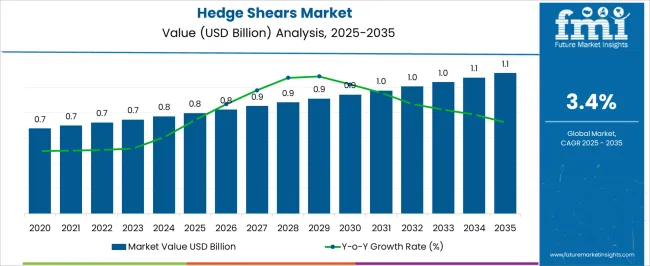
The hedge shears market is shaped by five key parent markets that influence its growth, applications, and technological innovation across residential and commercial sectors. The gardening and outdoor equipment market contributes the largest share, about 30-35%, as hedge shears are essential tools for homeowners and gardeners to maintain hedges, shrubs, and landscapes, offering precision, control, and ease of use for trimming. The landscaping services market adds approximately 20-24%, where professional landscapers rely on hedge shears for maintaining commercial and residential properties, parks, and public spaces, ensuring neat, well-kept landscapes for clients.
The home improvement and DIY market contributes around 15-18%, with consumers using hedge shears for personal landscaping projects and outdoor aesthetics, driven by growing interest in DIY gardening and home beautification. The agriculture and horticulture market accounts for roughly 12-15%, where hedge shears are used for pruning fruit trees, bushes, and other horticultural plants to improve yield, health, and aesthetics. The e-commerce and online retail market represents about 8-10%, as online platforms offer a wide variety of hedge shears, catering to consumer preferences for specific blade types, handle designs, and ergonomic features. Together, these parent markets highlight the importance of hedge shears in both professional landscaping and personal gardening, driven by demand for efficient, ergonomic, and durable tools that meet the needs of residential, commercial, and agricultural applications.
| Metric | Value |
|---|---|
| Hedge Shears Market Estimated Value in (2025 E) | USD 0.8 billion |
| Hedge Shears Market Forecast Value in (2035 F) | USD 1.1 billion |
| Forecast CAGR (2025 to 2035) | 3.4% |
The hedge shears market is experiencing steady growth, supported by increasing consumer interest in gardening, landscaping, and outdoor home improvement activities. Industry developments and product innovation announcements have showcased a rise in ergonomic designs, lightweight materials, and adjustable features, catering to both amateur gardeners and professional landscapers. Seasonal demand for lawn and hedge maintenance, combined with the growing trend of sustainable and aesthetically pleasing home gardens, has stimulated market adoption.
Manufacturers are diversifying their product lines with variations in blade size, cutting mechanisms, and handle adjustability to meet specific trimming needs. Additionally, online retail platforms and specialty gardening stores have broadened product accessibility, boosting sales volumes globally.
Over the forecast period, the market is expected to benefit from innovations in corrosion-resistant coatings, precision-ground blades, and shock-absorbing handle technologies. Segmental growth is anticipated to be led by extendable hedge shears, the 7 to 9 inches blade size range, and bypass edge blade types, reflecting a balance of functionality, user comfort, and cutting efficiency.
The hedge shears market is segmented by product type, blade size, blade type, blade material, price, end user, distribution channel, and geographic regions. By product type, hedge shears market is divided into Extendable hedge shears and Non-extendable hedge shears. In terms of blade size, hedge shears market is classified into 7 to 9 inches, Below 5 inches, 5 to 7 inches, and Above 9 inches. Based on blade type, hedge shears market is segmented into Bypass edge and Straight edge. By blade material, hedge shears market is segmented into Carbon steel, Alloy steel, Aluminum, Stainless steel, and Others (titanium etc.). By price, hedge shears market is segmented into Medium, Low, and High. By end user, hedge shears market is segmented into DIY and homeowners and Professionals. By distribution channel, hedge shears market is segmented into Offline and Online. Regionally, the hedge shears industry is classified into North America, Latin America, Western Europe, Eastern Europe, Balkan & Baltic Countries, Russia & Belarus, Central Asia, East Asia, South Asia & Pacific, and the Middle East & Africa.
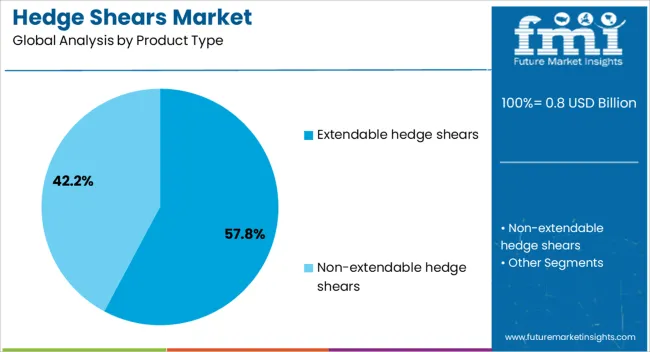
The extendable hedge shears segment is projected to account for 57.8% of the hedge shears market revenue in 2025, maintaining its lead due to its versatility and user convenience. Extendable designs have been preferred by both home gardeners and professionals for their ability to reach taller hedges and deeper shrubs without the need for ladders, reducing strain and improving safety.
Product engineers have incorporated lightweight yet durable telescopic handles, enabling easy length adjustments to suit different tasks. Consumer reviews and retail sales data indicate strong demand for extendable models in regions with larger residential gardens and professional landscaping services.
The ability to handle both fine shaping and heavy-duty cutting with adjustable reach has positioned this segment as the most practical choice for diverse trimming needs. With ongoing advancements in handle locking mechanisms and grip ergonomics, extendable hedge shears are expected to sustain their dominance in the market.
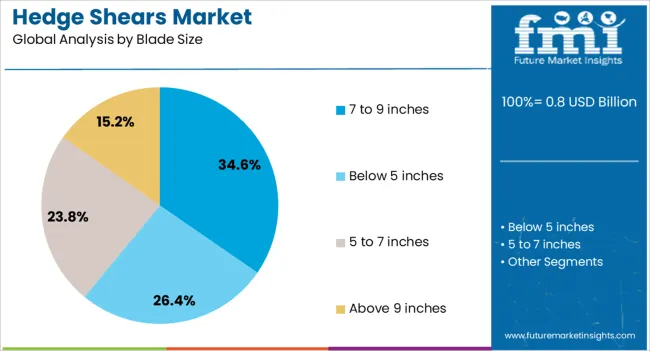
The 7 to 9 inches blade size segment is projected to hold 34.6% of the hedge shears market revenue in 2025, reflecting its suitability for precision and control in hedge maintenance. This blade size range has been widely adopted for balancing cutting efficiency with maneuverability, allowing users to shape hedges and shrubs accurately without excessive weight or fatigue.
Garden tool specialists have noted that 7 to 9-inch blades offer optimal leverage for clean cuts while remaining versatile for different hedge densities. Retail sales patterns show strong preference for this blade length among both casual users and professionals who prioritize accuracy in landscaping aesthetics.
Manufacturers have enhanced these blades with high-carbon steel construction and non-stick coatings, further improving cutting performance and durability. As consumer demand grows for tools that provide both precision and ease of handling, the 7 to 9 inches blade size segment is expected to retain its strong market position.
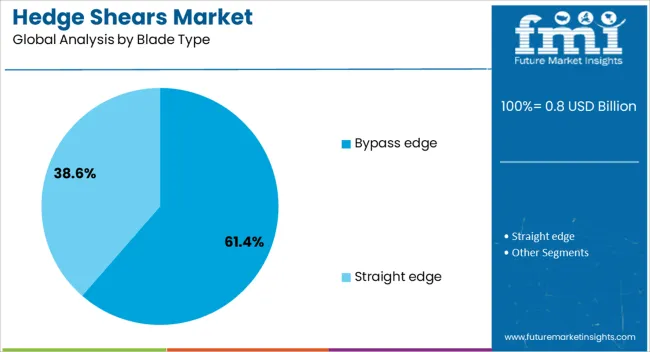
The bypass edge segment is projected to contribute 61.4% of the hedge shears market revenue in 2025, securing its position as the dominant blade type. Bypass edge blades have been favored for their ability to deliver clean, scissor-like cuts that promote plant health by minimizing tissue damage.
Professional landscapers and horticulturists have recommended bypass designs for live plant trimming due to their precision and reduced crushing effect compared to anvil-style blades. Advances in blade engineering, such as precision-ground edges and sap groove integration, have further improved performance and maintenance.
Consumer feedback has consistently highlighted smoother cutting action and reduced effort when using bypass blades for regular hedge upkeep. With increasing emphasis on maintaining healthy, aesthetically appealing hedges, the bypass edge segment is expected to remain the preferred choice across both residential and commercial landscaping applications.
The hedge shears market is expanding due to rising demand for efficient, ergonomic, and durable tools in both residential and professional landscaping. The shift towards battery-powered, cordless models and products with smart features is driving growth. Challenges include the high cost of materials, innovation in product differentiation, and competition. Opportunities exist in lightweight, energy-efficient, and eco-friendly hedge shears, with a focus on user comfort and performance. Manufacturers offering innovative designs, longer battery life, and advanced ergonomic features are well-positioned to capture market share. North America, Europe, and Asia-Pacific are key regions for market expansion.
The hedge shears market is growing as consumers and professional landscapers increasingly invest in high-performance tools for garden and landscape maintenance. Hedge shears are widely used for trimming hedges, shrubs, and bushes, providing a clean and even cut. As urbanization and interest in home gardening rise globally, particularly in North America, Europe, and Asia-Pacific, the demand for efficient and durable gardening tools is increasing. Brands like Fiskars, Bosch, and Black & Decker are enhancing their offerings with ergonomically designed handles, sharp blades, and lightweight materials to improve usability and reduce user fatigue. The market is also driven by the popularity of DIY gardening, particularly during post-pandemic home improvement trends.
The hedge shears market faces challenges related to production costs, material innovation, and the need for differentiation in a competitive landscape. Consumers expect higher durability, performance, and comfort, driving manufacturers to innovate with materials like carbon steel, stainless steel, and advanced composites. However, the cost of high-quality materials and specialized coatings for rust resistance can increase production costs. Differentiation in terms of handle ergonomics, blade sharpness, and cutting capacity is also crucial in capturing market share. Manufacturers must focus on developing premium products that balance cost-effectiveness with superior performance. The shift towards electric and battery-powered hedge shears requires investment in R&D and battery technology.
Battery-powered hedge shears offer convenience and mobility, eliminating the need for cords and providing a more user-friendly experience, particularly for professional landscapers and large property owners. Consumers are increasingly prioritizing comfort and reduced strain, fueling the demand for lightweight, ergonomically designed models with padded handles. Additionally, the increasing preference for eco-friendly products is prompting manufacturers to develop more energy-efficient, low-maintenance hedge shears. Innovations such as adjustable blade angles, quick blade replacement, and longer battery life are expected to drive growth in the market, particularly among urban gardeners and landscapers.
Technological trends in the hedge shears market include the increasing adoption of cordless technology, eco-friendly solutions, and smart features. Cordless hedge shears powered by lithium-ion batteries are becoming more popular due to their convenience, improved battery life, and portability. The market is also witnessing a shift towards eco-friendly models that produce fewer emissions and operate more efficiently. Smart features, such as adjustable cutting speeds, integrated sensors for optimal cutting, and IoT connectivity for real-time monitoring and maintenance, are being incorporated into higher-end models. These innovations enhance user experience and performance, positioning hedge shears as advanced tools for modern gardening and landscaping needs.
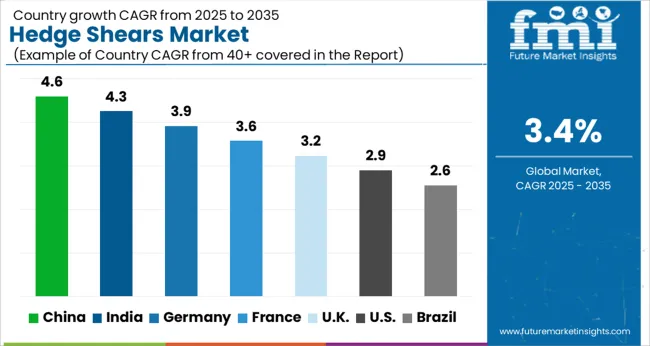
| Country | CAGR |
|---|---|
| China | 4.6% |
| India | 4.3% |
| Germany | 3.9% |
| France | 3.6% |
| UK | 3.2% |
| USA | 2.9% |
| Brazil | 2.6% |
Global hedge shears demand is projected to rise at a 3.4% CAGR from 2025 to 2035. China leads at 4.6%, followed by India at 4.3% and Germany at 3.9%, while the UK posts 3.2% and the United States records 2.9%. These rates translate to a growth premium of +35% for China, +26% for India, and +15% for Germany versus the baseline, whereas the UK and United States trail by -6% and -15%, respectively. Divergence reflects local catalysts: increasing demand for gardening tools in China and India, driven by urbanization and growing interest in home gardening, versus the slower growth in mature markets like the UK and USA, where household penetration is high and growth is more tied to replacement cycles. The analysis spans 40+ countries, with leading markets profiled below.
The hedge shears market in China is expected to grow at a CAGR of 4.6% from 2025 to 2035. As urbanization continues to rise, gardening is becoming an increasingly popular hobby, especially in metropolitan areas where residential spaces are being transformed into urban gardens. With a growing middle class and rising disposable incomes, more Chinese consumers are investing in home gardening and landscaping tools, including hedge shears. The market is also seeing a shift toward high-quality, durable products, with an increasing number of consumers preferring ergonomically designed tools for better comfort and efficiency. Additionally, the rapid expansion of e-commerce platforms in China is making gardening tools more accessible, allowing consumers across the country to purchase hedge shears online. The availability of a wide range of product offerings, from manual to electric hedge shears, is contributing to the market's growth.
The hedge shears market in India is projected to grow at a CAGR of 4.3% from 2025 to 2035. With rising disposable incomes and a growing urban population, India’s gardening sector is rapidly expanding. As more people move to urban areas and apartments, they are investing in home gardening to create green spaces in small living environments. The demand for hedge shears is particularly strong among middle-class consumers, who are becoming increasingly interested in maintaining their gardens, balconies, and rooftops.The gardening sector in India is seeing a surge due to the rise in DIY (do-it-yourself) gardening trends and the increasing number of gardening enthusiasts. Hedge shears are considered essential tools for maintaining hedges, shrubs, and small plants. The market is also benefiting from the growing popularity of online retail platforms, which are making gardening tools more accessible to consumers across India.
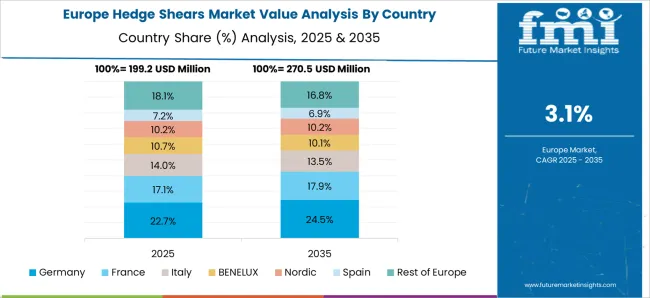
The hedge shears market in Germany is expected to grow at a CAGR of 3.9% from 2025 to 2035. The demand for hedge shears in Germany is driven by the country’s strong gardening culture, with many households regularly investing in gardening tools and maintaining lush gardens. The growing interest in eco-friendly gardening practices, such as organic gardening, has also driven demand for high-quality, sustainable gardening tools, including hedge shears. The German market is also witnessing an increasing preference for advanced tools like electric and battery-operated hedge shears, which offer higher convenience and better efficiency. As people continue to adopt smart gardening technologies, the demand for such specialized tools is expected to rise. Retail stores, as well as online platforms, are key distribution channels in Germany, offering consumers a variety of hedge shears from both local and international brands.
The UK hedge shears market is projected to grow at a CAGR of 3.2% from 2025 to 2035. The demand for hedge shears in the UK is primarily driven by the continued interest in gardening as a popular outdoor activity. The growing trend of creating personalized green spaces in small gardens and urban settings is fueling the need for gardening tools, including hedge shears. In addition, the UK has seen an increasing shift toward sustainable gardening practices, with consumers opting for eco-friendly and ergonomically designed tools that are both efficient and durable. While the market is mature, the demand for innovative, user-friendly hedge shears is still strong, particularly among homeowners who want to maintain their gardens with minimal effort. The expanding e-commerce market and availability of online gardening resources further boost the growth of the hedge shears market.

The USA hedge shears market is expected to grow at a CAGR of 2.9% from 2025 to 2035. Although the market is mature, the demand for hedge shears remains steady, driven by the high number of gardening enthusiasts and the increasing number of households with gardens or landscaped yards. Consumers in the USA are increasingly looking for tools that offer ease of use and efficient performance, leading to a rise in the adoption of electric and cordless hedge shears. The growing trend toward home beautification and outdoor living, combined with the DIY culture, contributes to sustained demand for gardening tools. While growth is relatively slower compared to emerging markets, the USA market remains significant due to the demand for high-quality, durable, and user-friendly tools. The market benefits from the continued presence of leading brands and the availability of a variety of products through both physical and online retail channels.

The hedge shears market is highly competitive, with key players such as Fiskars, Bahco, Barnel, Benson, Corona, Echo, Felco, Hart, Husky, Husqvarna, Kanenori, Stanley Black & Decker, Stihl, Tata Agrico, and Woodland Tools competing for market share. Fiskars leads with its ergonomic, lightweight designs, which focus on ease of use and efficiency. Product brochures highlight features like non-stick coated blades, comfort grip handles, and precision cutting, catering to both professionals and DIY enthusiasts. Bahco emphasizes durability and precision, offering shears with advanced blade technology. Its brochures focus on the high-quality materials and long-lasting performance, targeting gardening professionals who require robust tools for frequent use. Barnel and Benson cater to users seeking heavy-duty hedge shears. Barnel’s product brochures emphasize high-strength steel blades, ergonomic handles, and precision cutting for both residential and commercial users.
Benson focuses on value-for-money products, offering reliable shears at a competitive price point, with brochures showcasing ease of maintenance and efficient cutting action. Corona and Echo offer similar features, positioning themselves as affordable yet reliable options for homeowners and gardeners. Their product brochures highlight comfort, cutting capacity, and user-friendly designs. Felco is recognized for its premium shears designed for professional landscapers. The company's brochures emphasize Swiss craftsmanship, precision blades, and lifetime warranty, making it a favorite among professionals.
Hart, Husky, and Husqvarna focus on high-performance shears with special attention to blade longevity, ease of use, and versatility. Their product brochures highlight features such as shock-absorbing handles and corrosion-resistant coatings, catering to both casual gardeners and landscapers. Stanley Black & Decker, Stihl, Tata Agrico, and Woodland Tools target a broad market, emphasizing durability, comfort, and cutting efficiency. Their brochures feature versatile, multi-purpose shears designed to cater to various garden sizes, with added highlights on ease of maintenance and affordability.
| Item | Value |
|---|---|
| Quantitative Units | USD 0.8 Billion |
| Product Type | Extendable hedge shears and Non-extendable hedge shears |
| Blade Size | 7 to 9 inches, Below 5 inches, 5 to 7 inches, and Above 9 inches |
| Blade Type | Bypass edge and Straight edge |
| Blade Material | Carbon steel, Alloy steel, Aluminum, Stainless steel, and Others (titanium etc.) |
| Price | Medium, Low, and High |
| End User | DIY and homeowners and Professionals |
| Distribution Channel | Offline and Online |
| Regions Covered | North America, Europe, Asia-Pacific, Latin America, Middle East & Africa |
| Country Covered | United States, Canada, Germany, France, United Kingdom, China, Japan, India, Brazil, South Africa |
| Key Companies Profiled | Fiskars, Bahco, Barnel, Benson, Corona, Echo, Felco, Hart, Husky, Husqvarna, Kanenori, Stanley Black & Decker, Stihl, Tata Agrico, and Woodland Tools |
| Additional Attributes | Dollar sales by product type (manual hedge shears, powered hedge trimmers), blade material (stainless steel, carbon steel, titanium-coated), and handle type (ergonomic, extendable, telescopic). Demand is driven by urban gardening trends, landscaping needs, and the increasing preference for eco-friendly, easy-to-use garden tools. Regional trends highlight growth in North America, Europe, and Asia-Pacific, fueled by an increase in gardening activities, landscaping services, and demand for high-quality garden tools. |
The global hedge shears market is estimated to be valued at USD 0.8 billion in 2025.
The market size for the hedge shears market is projected to reach USD 1.1 billion by 2035.
The hedge shears market is expected to grow at a 3.4% CAGR between 2025 and 2035.
The key product types in hedge shears market are extendable hedge shears and non-extendable hedge shears.
In terms of blade size, 7 to 9 inches segment to command 34.6% share in the hedge shears market in 2025.






Our Research Products

The "Full Research Suite" delivers actionable market intel, deep dives on markets or technologies, so clients act faster, cut risk, and unlock growth.

The Leaderboard benchmarks and ranks top vendors, classifying them as Established Leaders, Leading Challengers, or Disruptors & Challengers.

Locates where complements amplify value and substitutes erode it, forecasting net impact by horizon

We deliver granular, decision-grade intel: market sizing, 5-year forecasts, pricing, adoption, usage, revenue, and operational KPIs—plus competitor tracking, regulation, and value chains—across 60 countries broadly.

Spot the shifts before they hit your P&L. We track inflection points, adoption curves, pricing moves, and ecosystem plays to show where demand is heading, why it is changing, and what to do next across high-growth markets and disruptive tech

Real-time reads of user behavior. We track shifting priorities, perceptions of today’s and next-gen services, and provider experience, then pace how fast tech moves from trial to adoption, blending buyer, consumer, and channel inputs with social signals (#WhySwitch, #UX).

Partner with our analyst team to build a custom report designed around your business priorities. From analysing market trends to assessing competitors or crafting bespoke datasets, we tailor insights to your needs.
Supplier Intelligence
Discovery & Profiling
Capacity & Footprint
Performance & Risk
Compliance & Governance
Commercial Readiness
Who Supplies Whom
Scorecards & Shortlists
Playbooks & Docs
Category Intelligence
Definition & Scope
Demand & Use Cases
Cost Drivers
Market Structure
Supply Chain Map
Trade & Policy
Operating Norms
Deliverables
Buyer Intelligence
Account Basics
Spend & Scope
Procurement Model
Vendor Requirements
Terms & Policies
Entry Strategy
Pain Points & Triggers
Outputs
Pricing Analysis
Benchmarks
Trends
Should-Cost
Indexation
Landed Cost
Commercial Terms
Deliverables
Brand Analysis
Positioning & Value Prop
Share & Presence
Customer Evidence
Go-to-Market
Digital & Reputation
Compliance & Trust
KPIs & Gaps
Outputs
Full Research Suite comprises of:
Market outlook & trends analysis
Interviews & case studies
Strategic recommendations
Vendor profiles & capabilities analysis
5-year forecasts
8 regions and 60+ country-level data splits
Market segment data splits
12 months of continuous data updates
DELIVERED AS:
PDF EXCEL ONLINE
Hedge Trimmers Market Growth - Trends & Forecast 2025 to 2035
Electric Hedge Trimmer Market Insights Demand, Size & Industry Trends 2025 to 2035

Thank you!
You will receive an email from our Business Development Manager. Please be sure to check your SPAM/JUNK folder too.
Chat With
MaRIA